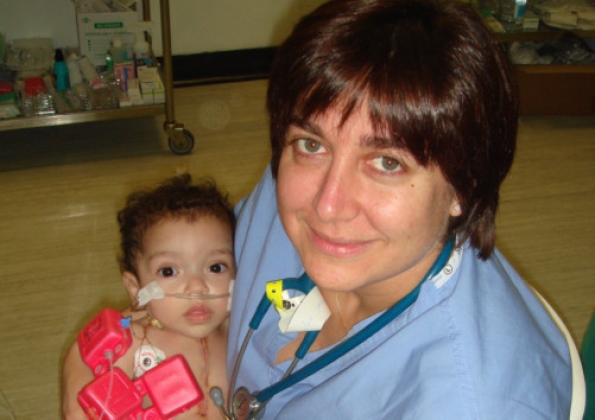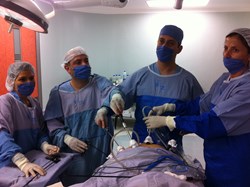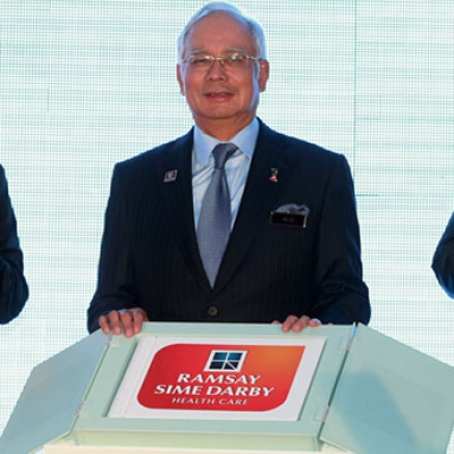
Fatemah Rajah and Sulleman Moreea, below.
A medical couple from Yorkshire are dedicating any spare time they have when not saving lives in the county’s hospitals to helping others in developing countries. Catherine Scott meets them.
Most people with stressful jobs look forward to their annual holidays as a break from their daily routine, a chance to unwind and relax.
Not medical couple Drs Sulleman Moreea and Fatemah Rajah.
Instead of lying on a beach or touring Europe, these two dedicated doctors from West Park, Leeds spend the vast proportion of their annual leave helping others in developing countries,
Sulleman, a consultant at Bradford Royal Infirmary spends at least three-quarters of his annual leave either training doctors in his native Mauritius or helping to set up endoscopy units in St Lucia.

Fatemah, a paediatric intensivist (a specialist in intensive care) with Sheffield Children’s Hospital’s EMBRACE team, spends her holidays volunteering for the International Child Heart Foundation. The foundation sends medics to different parts of the world to save lives and train people how to carry out heard surgery on children. Fatemah has been to Ecuador, Egypt and the Ukraine.
“It does mean we don’t see much of each other in the holidays,” says Sulleman. “What I do is nothing compared to what my wife does for charity.”
It was while on a rare holiday in St Lucia that Sulleman met a taxi driver who was to change his relationship with the island forever.
“It was a long journey and late at night as our plane had been delayed,” explains Sulleman.“I started asking him questions about the medical facilities in St Lucia.”
It turned out that the man was moonlighting as a taxi driver and he was in fact an IT consultant at a local hospital. Dr Moreea, a consultant gastroenterologist and hepatologist, learnt that St Jude’s Hospital, relied on both public money, private donations and the support of foreign doctors and nurses.
He requested a meeting with the medical director and chairman to ask what he could do to help. After being shown around the hospital, Sulleman was told it had no facilities for gastrointestinal endoscopy; the specialist medical equipment used to peer inside patients to examine and even treat diseases of the digestive tract.
He was already heavily involved in training doctors and developing endoscopy units in Mauritius after meeting the country’s Prime Minister a few years earlier.
“There are no medical schools in Mauritius and after my A-levels I got a scholarship to Leeds University where I have done all my studying, I love Yorkshire but I knew one day that I would give something back to my homeland,” says Sulleman.
He returns to Mauritius four times a year and has helped set up three endoscopy units, a fourth is planned, all in his own time and with his own money.
“When the Yorkshire Clinic was updating its endoscopy unit I asked if I could have the old equipment. When I went to Mauritius I realised they didn’t need the equipment but then I went to St Lucia and they did.”
He initially returned to St Lucia in August 2009, with £100,000 worth of equipment for St Jude’s Hospital, where he spent a week training doctors.
However, the entire unit burnt down ten days later in a fire which killed three staff. All medical equipment was lost.
“It was devastating,” he says.
Whilst preparations were being made for St Jude’s to be re-built, Dr Moreea sought donations from Pentax and Olympus, who donated equipment worth hundreds of thousands of pounds to the new unit whose plans are being overseen by his friend, Swiss architect, Oliver Zuber.
“This will ensure that the facilities are almost on a par with what we have in Bradford,” said Sulleman,who was then approached by Dr Lisa Charles, MD of the Victoria Hospital, in north St Lucia, who had heard about his work and invited him to set up a similar endoscopy unit there.
“This was the chance of a lifetime,” added Dr Moreea who has recently become a special adviser to St Lucia’s Chief Medical Officer and Minister for Health.
“To be able to bring new procedures to St Lucia from which patients would benefit was an offer I couldn’t refuse.
“My aim is to institute a culture of teaching, whereby people who have been trained will in turn pass on their knowledge to their juniors, as we do here in the UK.
“It is our duty as doctors to pass on knowledge and it does give you are great sense of satisfaction.
“It gives me enormous satisfaction to be able to help those less fortunate than us, here in the UK.”
A sentiment echoed by his wife: “Every time I come back to this country is makes me realise how lucky we are,” she says.
It was while training in Liverpool that Fatemah got involved with the International Child Heart Foundation.
“I had heard about a trip to Morocco with the Foundation and I really wanted to get involved.”
She now travels at least twice a year to a variety of different countries helping them establish children’s heart surgery programmes.
Without the teams work many of the children would not have survived.
Like her husband she doesn’t view what she does as exceptional.
“Someone has taken the time and money to train us to become doctors and it is our duty to pass on the knowledge we have learned to other, especially in countries less fortunate than our own,” she says.
“Working in these countries with less equipment makes me think on my feet and makes me a better doctor.”
Twitter@ypcscott
Foundation spreads care worldwide
In developing countries, congenital heart defects often go undiagnosed until the child begins turning blue and having difficulty eating.
A simple procedure performed by skilled surgeons could save many children. The challenge is to get skilled doctors to the children in time to save them.
The International Children’s Heart Foundation strives to correct this unfortunate situation by:
Providing direct care to as many children as possible in the short term,
Sending medications, surgical supplies and diagnostic equipment to medical facilities in developing countries;
Training surgeons and medical staff so they ultimately can provide care for their own people.
The foundation was founded 20 years ago by William M. Novick. As a trained and successful cardiac surgeon, he wanted to bring the resources and expertise of the developed world to the children in the developing nations. So he began to gather supplies and volunteers. In 1993, he made his first team trip to Zagreb, Croatia and operated on 13 children.
source: http://www.yorkshirepost.co.uk / Yorkshire Post / Home> Health & Family / September 26th, 2013





